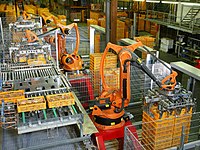
Photo from wikipedia
The diversity and complexity of biotechnological applications are constantly increasing, with ever expanding ranges of production hosts, cultivation conditions and measurement tasks. Consequently, many analytical and cultivation systems for biotechnology… Click to show full abstract
The diversity and complexity of biotechnological applications are constantly increasing, with ever expanding ranges of production hosts, cultivation conditions and measurement tasks. Consequently, many analytical and cultivation systems for biotechnology and bioprocess engineering, such as microfluidic devices or bioreactors, are tailor-made to precisely satisfy the requirements of specific measurements or cultivation tasks. Additive manufacturing (AM) technologies offer the possibility of fabricating tailor-made 3D laboratory equipment directly from CAD designs with previously inaccessible levels of freedom in terms of structural complexity. This review discusses the historical background of these technologies, their most promising current implementations and the associated workflows, fabrication processes and material specifications, together with some of the major challenges associated with using AM in biotechnology/bioprocess engineering. To illustrate the great potential of AM, selected examples in microfluidic devices, 3D-bioprinting/biofabrication and bioprocess engineering are highlighted.
Journal Title: New biotechnology
Year Published: 2017
Link to full text (if available)
Share on Social Media: Sign Up to like & get
recommendations!